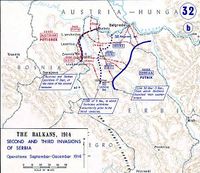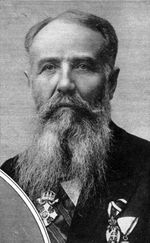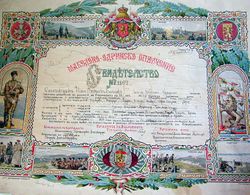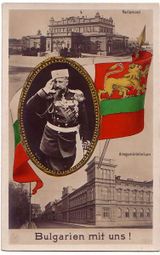الحملة الصربية في الحرب العالمية الأولى
| الحملة الصربية | |||||||
|---|---|---|---|---|---|---|---|
| جزء من مسرح البلقان في الحرب العالمية الأولى | |||||||
 المشاة الصربية المتمركزة في Ada Ciganlija. | |||||||
| |||||||
| المتحاربون | |||||||
|
|
| ||||||
| القادة والزعماء | |||||||
|
|
| ||||||
| القوى | |||||||
|
1914: |
1914: | ||||||
| الضحايا والخسائر | |||||||
|
|
| ||||||
الحملة الصربية في الحرب العالمية الأولى نشبت في أواخر يوليو 1914، حين غزت النمسا-المجر مملكة صربيا في بداية الحرب العالمية الأولى، وحتى نهاية الحرب في نوفمبر 1918. الجبهة اشتعلت من الدانوب إلى جنوب مقدونيا ثم إلى الشمال مرة أخرى، وشاركت فيها قوات تقريباً من كل الدول المتنازعة في الحرب.
انخفض عديد الجيش الصربي بشدة مع نهاية الحرب، من نحو 420,000[2] في أوجه إلى نحو 100,000 عند التحرير. وقد فقدت مملكة صربيا أكثر من 1,100,000 نسمة أثناء الحرب (خسائر العسكريين والمدنيين معاً)، مما مثل ما يزيد عن 27% من إجمالي تعداد المملكة ونحو 60% من تعداد الذكور.[5][6] وحسب تقديرات الحكومة اليوغسلاڤية (1924) فقد فقدت صربيا 265,164 جندياً، أو 25% من إجمالي التعبئة الوطنية. بالمقارنة، فقدت فرنسا 16.8%، ألمانيا 15.4%، روسيا 11.5%، وإيطاليا 10.3%.
خلفية

مقارنة القوى
Figures represent the numbers of all Austro-Hungarian troops concentrated on southern (Serbian) theater at the beginning of August and the entire Serbian army, the number of troops actually available for the operations on both sides was however somewhat lesser.
| Type | النمسا-المجر[7] | الصرب |
|---|---|---|
| Battalions | 329 | 209 |
| Batteries | 143 | 122 |
| Squadrons | 51 | 44 |
| Engineer Companies | 45 | 22 |
| المدفعية الميدانية | 756 | 558 ( 348 QF ) |
| المدافع الرشاشة | 490 | 210 |
| إجمالي المتقاتلين | 378,000 | 250,000 |
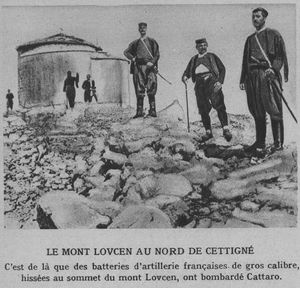
Serbia's ally Montenegro mustered an army of some 35-40,000 men with only 14 modern quick firing field guns and some 51 older pieces (some of them being antique models from 1870's) and 62 machine guns. Unlike Austro-Hungary and the Serbian army, the Montenegrin army was of militia type without proper military training or a career officer's corps.
ملاحظة:
according to AH military formation[8] average war strength of following units was:
Battalion:1000 ( combatants )
Battery: 196
Squadron: 180
Engineer Companies: 260
Strength of corresponding Serbian units was similar:
Battalion: 1116 ( combatants and non-combatants )
Battery: 169
Squadron: 130
Engineer Company: 250
Heavy artillery
| Austro-Hungarian | Serbian |
|---|---|
|
12 mobile batteries: 4 305 mm mortars 2 240 mm mortars 20 150 mm howitzers 16 120 mm cannons Additionally A-H fortresses and garrisons near the Serbian and Montenegrin borders ( Petrovaradin, Sarajevo, Kotor etc. ) had about 40 companies of heavy fortress artillery of various models. |
12 mobile batteries: 6 150 mm mortars Schneider-Canet M97 22 120 mm howitzers Schneider-Canet M97 |
النسق القتالي للجيش الصربي
الجيش الأول
General Petar Bojović, Commanding First Army
Colonel Božidar Terzić, Chief of Staff
| الفرق | Regiments |
|---|---|
| Cavalry division:
|
|
| Timok division I ban:
|
|
| Timok division II ban:
|
|
| Morava division II ban
|
|
|
Braničevo detachment (Dunav division II ban) |
troops of Dunav division II ban:
other troops:
|
| Army artillery
|
الجيش الثاني
General Stepa Stepanović, Commanding Second Army
Colonel Vojislav Živanović, Chief of Staff
| Divisions | Regiments |
|---|---|
| Morava division I ban
|
|
|
Combined division I ban
|
|
|
Šumadija division I ban |
|
|
Dunav division I ban
|
|
| Army artillery
|
الجيش الثالث
General Pavle Jurišić Šturm, Commanding Third Army
Colonel Dušan Pešić, Chieff of Staff
| Divisions and brigades | Regiments |
|---|---|
| Drina division I ban
|
|
| Drina division II ban
|
|
| Obrenovac detachment
|
|
| other units:
|
|
| Army artillery:
|
Army group Užice
General Miloš Božanović
| Divisions and brigades | Regiments |
|---|---|
| Šumadija division II ban
|
|
| Užice brigade
|
|
| detachments:
|
|
| Army artillery:
|
النسق القتالي لقوات النمسا-المجر في المسرح الصربي، أغسطس 1914.
قوة البلقان
5. Army
commander : Liborius Ritter von Frank
9. فرقة مشاة
21. landwehr infantry division
36. infantry division
42. domobran infantry division
13. infantry brigade
11. mountain brigade
104. landsturm infantry brigade
13. march brigade
6. Army
commander : Oskar Potiorek
1. infantry division
48. infantry division
18. infantry division
47. infantry division
40. honved infantry division
109. landsturm infantry brigade
Banat Rayon and garrisons
107. landsturm infantry brigade
sundry units of infantry, cavalry and artillery
From the 2. Army
commander : Eduard von Böhm-Ermolli
17. infantry division
34. infantry division
31. infantry division
32. infantry division
29. infantry division
7. infantry division
23.infantry division
10. cavalry division
4. march brigade
7. march brigade
8. march brigade
1914
معركة تسير
معركة درينا
Winston Churchill, The Great War.[9]
معركة كولوبارا
1915
Prelude
Course of the Campaign
1916–1918
End of the War
The ramifications of the war were manifold. When World War I ended, the Treaty of Neuilly gave Greece Western Thrace, and Serbia some minor territorial concessions from Bulgaria. Austria-Hungary was broken apart and Hungary lost much land to both Yugoslavia and Romania in the Treaty of Trianon. Serbia assumed the lead position in the new state of Yugoslavia, joined by its old ally, Montenegro. Meanwhile, Italy established a quasi-protectorate over Albania and Greece reoccupied Albania's southern part, which was autonomous under a local Greek provisional Government (see Autonomous Republic of Northern Epirus).
الخسائر


Before the war, the Kingdom of Serbia had 4,500,000 inhabitants.[11] According to the New York Times, in 1915 alone 150,000 people are estimated to have died during the worst typhus epidemic in world history. With the aid of the American Red Cross and 44 foreign governments, the outbreak was brought under control by the end of the year.[12] The number of civilian deaths is estimated by some sources at 650,000, primarily due to the typhus outbreak and famine, but also direct clashes with the occupiers.[13] Serbia's casualties accounted for 8% of the total Entente military deaths. 58% of the regular Serbian Army (420,000 strong) perished during the conflict.[14] The total number of casualties is placed around 1,000,000:[15] 25% of Serbia's prewar size, and an absolute majority (57%) of its overall male population.[16] L.A. Times and N.Y. Times also cited over 1,000,000 victims in their respective articles.[17][18]
Attacks against ethnic Serb civilians


انظر أيضاً
- Momčilo Gavrić (soldier)
- انسحاب الجييش الصربي عبر ألبانيا (الحرب العالمية الأولى)
- الحرب العالمية الأولى
- خسائر الحرب العالمية الأولى
الهامش
- ^ Österreich-Ungarns letzter Krieg — Wien: Verlag der Militärwissenschaftlichen Mitteilungen, 1930. — Vol. 1. pg. 759. This is the total number of soldiers who served on the Balkans until the middle of December 1914.
- ^ أ ب http://www.vojska.net/eng/world-war-1/serbia/organization/1914/
- ^ Thomas & Babac. "Armies in the Balkans 1914–1918" pg.12
- ^ أ ب Георги Бакалов, "История на Българите: Военна история на българите от древността до наши дни", p.463
- ^ Чедомир Антић, Судњи рат, Политика од 14. септембра 2008.
- ^ Владимир Радомировић, Највећа српска победа, Политика од 14. септембра 2008.
- ^ خطأ استشهاد: وسم
<ref>غير صحيح؛ لا نص تم توفيره للمراجع المسماةReferenceA - ^ Österreich-Ungarns letzter Krieg 1914 - 1918, vol. 1, Wienn 1930, p.82
- ^ Jordan 2008, p. 25
- ^ Mitrović 2007, p. 223.
- ^ Serbia in 1914
- ^ "$1,600,000 was raised for the Red Cross" (PDF). The New York Times. 29 October 1915.
- ^ http://www.firstworldwar.com/features/minorpowers_serbia.htm
- ^ Serbian army, August 1914
- ^ Tema nedelje: Najveća srpska pobeda: Sudnji rat: POLITIKA
- ^ Тема недеље : Највећа српска победа : Сви српски тријумфи : ПОЛИТИКА (صربية)
- ^ Fourth of Serbia's population dead.
- ^ Asserts Serbians face extinction
- ^ Honzík, Miroslav; Honzíková, Hana (1984). 1914/1918, Léta zkázy a naděje. Czech Republic: Panorama.
المصادر
الكتب
- Falls, Cyril, The Great War (1960)
- Esposito, Vincent (ed.), The West Point Atlas of American Wars – Vol. 2; maps 46–50. Frederick Praeger Press (1959)
- Österreich-Ungarns letzter Krieg 1914 - 1918, vol. 1, Wienn 1930
- Österreich-Ungarns letzter Krieg 1914 -1918, vol. 2 Beilagen, Wienn 1931
- Franek, Fritz, Die Entwicklung der öst.-ung. Wehrmacht in den ersten zwei Kriegsjahren, Wienn 1933
- Jordan, David (2008). The Balkans, Italy & Africa 1914–1918: From Sarajevo to the Piave and Lake Tanganyika. London, United Kingdom: Amber Books Ltd. ISBN 978-1-906626-14-3.
{{cite book}}: Invalid|ref=harv(help) - Mitrović, Andrej (2007). Serbia's Great War, 1914-1918. West Lafayette, Indiana: Purdue University Press. ISBN 978-1-5575-3476-7.
{{cite book}}: Invalid|ref=harv(help) - Willmott, H. P. (2003). World War One. Dorling Kindersley Publishing, Incorporated. ISBN 0789496275.
| أظهر بلغاريا في الحرب العالمية الأولى |
|---|


